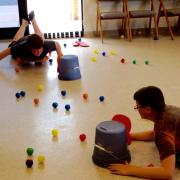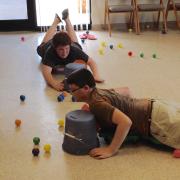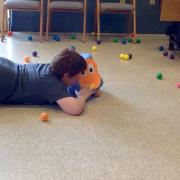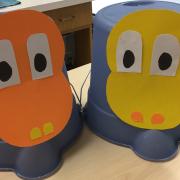Hungry Hungry Hippos is a life-sized version of the classic tabletop game. Participants play as the hippos, and their objective is to collect the most plastic balls before time runs out. Starting from different corners of the room, the players move around on scooters and can only use their “mouths” — plastic buckets — to capture the balls.
Advanced Planning
My goal for this program was to offer something fun and offbeat that embodied the summer reading theme of games and fitness. I structured my summer programming around a series of life-sized games (including Jenga and Pac-Man) and hoped that, by being interesting and memorable, they would generate a lot of interest in the teen summer reading program.
About a month in advance, I started gathering the materials — balls, buckets and scooters — and looking online for more information on past Hungry Hungry Hippos programs. The basic idea is pretty simple, so the toughest part was figuring out which materials worked best with my space and budget. I had to keep in mind that I might have a very large group or a very small group, so I needed to be prepared for either of those scenarios. The large group posed more problems: I had to consider whether or not I would divide everyone into teams, how long a round would last, and how prizes would be awarded.
Marketing
Hungry Hungry Hippos kicked off our teen summer reading program, so we started promoting these programs collectively while school was still in session. We handed out summer reading brochures at the schools and had them available at the library information desks for about a month before the event took place. We also had fliers specifically promoting Hungry Hungry Hippos and publicized it on social media, in the newspaper and on the radio. Although the teen turnout was relatively low, our marketing also caught the eye of a local newspaper, and we were featured in a front page write-up the day after the event.
Budgeting
The program didn’t require many materials, and fortunately we already had some of them on hand. There are three main components of the game: buckets, scooters and plastic balls. These are all needed in some variation, but a budget-conscious library can get creative in which items fulfill these roles.
We already had four buckets and several scooters from previous programs. All I needed to purchase was a set of 200 plastic balls from Amazon for $13. This is probably the minimum number of balls you would need; if you have a particularly large space, it might be wiser to purchase at least 300. The scooters we used go for about $15 a piece, and because they are meant for children, I let each teen use two. A cheaper alternative might be to ask any skateboarding patrons to lend their skateboards for the event. The plastic buckets can be purchased at the dollar store, as they do not need to be very sturdy for this program.
The last item I used was an iPad to play music; each round lasted the duration of a song, so this was very important. Any device that can play music would suffice.
Day-of-event Activity
On the day of the event, I made sure that all of the tables and chairs in our programming room were cleared to make room for the game. I brought the materials into the room, but I didn’t set up the scooters or balls because I didn’t want the participants to shift anything around before we started playing. The teens who arrived early helped me cut hippo heads out of neon-colored paper to make our buckets look more festive.
At the start time, I had everyone pick their scooters and buckets and get into position before I emptied the balls in the middle of the room. Because only three teens showed up, I ended up not needing much staff assistance. It was helpful to have someone there to take pictures and videos while I refereed and kept track of time, but I didn’t need to have another staff member present for the entire program.
The biggest challenge I faced was in having such a small group; because they all got to play every round and faced the same competition each time, the game soon got tedious. I introduced variations based on time limit and ball color to keep it exciting.
Program Execution
The program itself was a mixed success: only three teens attended, but they all enjoyed it immensely. The newspaper coverage that the library received increased awareness of our summer programs, and the teens themselves gave glowing reviews in the article. They all suggested that we offer it again during the school year, when more teens come to the library for programming. All in all, I was pleased with the outcome. The program was well-received by the participants, and it brought more attention to what our library has to offer.
Advice
A Hungry Hungry Hippos program is easier than it looks, as long as you have a large enough space for it. It is simple enough to adapt to almost any budget and might even use some things that you already have at your library. The most important thing to remember is to gather your materials ahead of time and determine how many participants you will be able to accommodate.
The program is loud and spirited, so a closed-off programming space is a must. The rules of the game may need to be adjusted depending on how many patrons show up, so have a plan of how to deal with both large and small groups. Even after all this preparation, you may find that there are still modifications to make during the program to suit your participants’ needs. Be ready for a program that is animated and often chaoti c —but also expect your teens to have a lot of fun.
Supporting Materials
- Feedback (Coming Soon!)
- Programming Librarian Facebook Group







